AMD Announces Ryzen 5000 C-Series For High-End Chromebooks
by Gavin Bonshor on May 5, 2022 4:30 PM EST- Posted in
- CPUs
- Acer
- AMD
- HP
- Chromebook
- Ryzen Mobile
- Ryzen C-Series
- Ryzen 5000
- Zen3
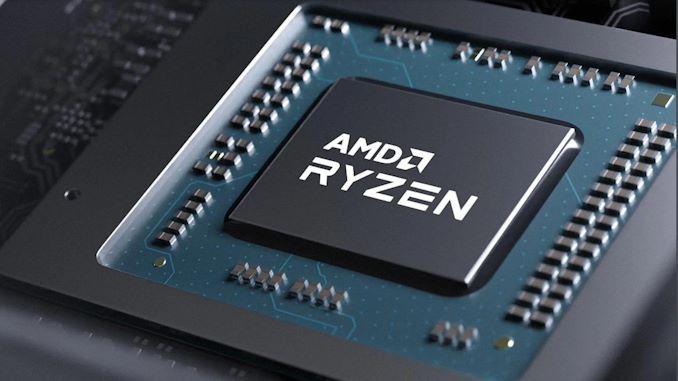
In September 2020, AMD released its Ryzen 3000 C-series for Chromebooks, a line up of budget-priced chips based on the 12nm Picasso (Ryzen+) architecture that featured up to 4 cores and 8 threads and up to 11 Radeon Vega compute units. Nearly two years on and AMD has just announced four new Ryzen 5000 C-series SKUs designed to bring the performance benefits of its Cezanne (Zen 3) architecture to the Chromebook space.
The four new Ryzen 5000 C-series processors range from 8C/16T to 2C/4T, all with a 15 W TDP and designed to improve productivity and battery life over existing Ryzen 3000 C-series processors and Intel's 11th Gen Tiger Lake chips.
Aimed at the premium area of the Chromebook market, the new AMD Ryzen 5000 C-series looks to offer OEMs and users premium options for the latest generation of Chromebooks with some higher-end features such as fast charging and Wi-Fi 6E networking capability.
| AMD Ryzen 5000 C-Series For Chromebooks (Zen 3) | ||||||||
| AnandTech | Core/ Thread |
Base Freq |
1T Freq |
L2/L3 Cache |
iGPU | iGPU Freq |
TDP | |
| Ryzen 7 5825C | 8 | 16 | 2000 | 4500 | 20 MB | Vega 8 | Up to 1.8 GHz | 15 W |
| Ryzen 5 5625C | 6 | 12 | 2300 | 4300 | 19 MB | Vega 7 | Up to 1.6 GHz | 15 W |
| Ryzen 3 5425C | 4 | 8 | 2700 | 4100 | 10 MB | Vega 6 | Up to 1.5 GHz | 15 W |
| Ryzen 3 5125C | 2 | 4 | 3000 | 3000 | 9 MB | Vega 3 | Up to 1.2 GHz | 15 W |
Looking at the specifications of the Ryzen 5000 C-series line-up, the top model is the Ryzen 7 5825C with an impressive 8 cores and 16 threads which is double that of the previous top-tier Chromebook Ryzen processor, the AMD Ryzen 7 3700C. It has a base core frequency of 2 GHz, with a boost core clock of up to 4.5 GHz on a single core, which is bolstered by its Radeon Vega 8 integrated graphics with a maximum boost frequency of up to 1.8 GHz.
The second model in the new line-up is the Ryzen 5 5625C, which has 6 cores, 12 threads, and integrated Radeon Vega 7 graphics with a maximum boost frequency of up to 1.6 GHz. The 6 cores feature a base frequency of 2.3 GHz, while one of these cores can boost up to 4.3 GHz for applications that demand additional performance.
Focusing on the two entry-level models in the line-up, the Ryzen 3 5425C benefits from 4 cores and 8 threads with a base frequency of 2.7 GHz, with a boost frequency on one core of up to 4.1 GHz, as well as AMD's Radeon Vega 6 graphics that can boost up to 1.5 GHz. The Ryzen 3 5125C is the lowest in the new C-series stack with just 2 cores and 4 threads, has a consistent core clock speed of 3 GHz, and has 3 Vega graphics compute cores with a maximum boost frequency of up to 1.2 GHz.
As we go from top to bottom, each model in the line-up increases in base core frequency, while the boost clocks bar the Ryzen 3 5125C, which has a set core clock speed of 3 GHz, experience a drop in frequency. All the Ryzen 5000 C-series models feature a 15 W TDP envelope, so core frequency on both the Zen 3 cores and the Radeon Vega cores will depend on the application, task, or game being used to optimize the relative power envelope to fit within the 15 W TDP threshold.
While we don't typically concern ourselves with vendor-given performance data, perhaps the most impressive of AMD's claims is battery life. AMD is claiming that the Ryzen 5 5625C has up to improve battery life by 94% when directly compared to Intel's Core i5-1135G7 processor, which, if true, is very impressive. One of the main benefits of the Chromebook series is usability, and having an improved battery life can increase overall productivity and lifespan when using it while traveling between charges.
So far, AMD has announced two of its partners already on board with its Ryzen 5000 C-series for Chromebooks, including HP and Acer. Both are launching new models due later on in the year, but AMD highlighted two new models:
HP Elite C645 G2 Chromebook
The first of the new Chromebooks to feature AMD's Ryzen 7 5825C processor is the HP Elite C645 G2. HP is expected to offer multiple display options, including various configurations of its 14" 1080p touchscreen panel and plenty of impressive features. These include support for up to 16 GB of LPDDR4X memory with up to 512 GB of PCIe storage. Other features include the latest Wi-Fi 6E wireless and BT 5.2 connectivity and an optional 4G LTE version. The HP Elite C645 will also have a 5 MP integrated webcam, a SmartCard terminal for a CAD-capable keyboard, and an SEC fingerprint sensor for added security.
The HP Elite C645 G2 Chromebook is expected to hit retail shelves in Q2 2022, with pricing currently unknown.
Acer Chromebook Spin 514
The second of the new Ryzen 5000 C-series Chromebooks is the Acer Chromebook Spin 514, which is a 2-in-1 convertible with a 14" touchscreen. Acer is using the AMD Ryzen 7 5825C processor in this model, and it can support up to 256 GB of PCIe Gen 3 storage and support the latest Wi-FI 6E routers with BT 5.2 connectivity. Acer has specified that the Chromebook Spin 514 includes military-grade MIL-STD 810 durability with a Corning gorilla glass touchscreen panel that supports sRGB 100% color.
At the time of writing, Acer says the Chromebook Spin 514 will be available in Q3 2022, with expected pricing not disclosed.
It is expected that more vendors will adopt AMD's Ryzen 5000 C-series processors for Chromebooks in the coming months, although these are OEM only, and pricing is currently unknown on each of the models.
Source: AMD


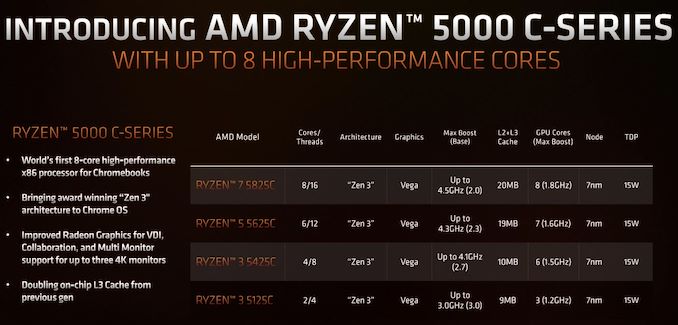
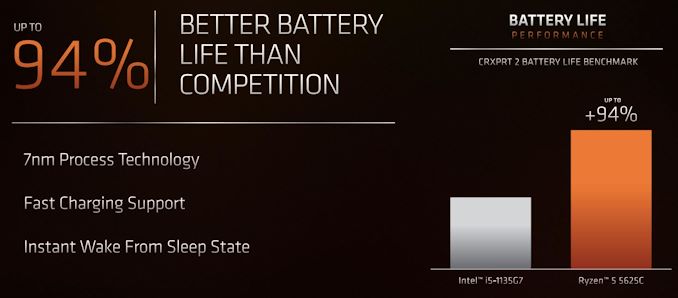
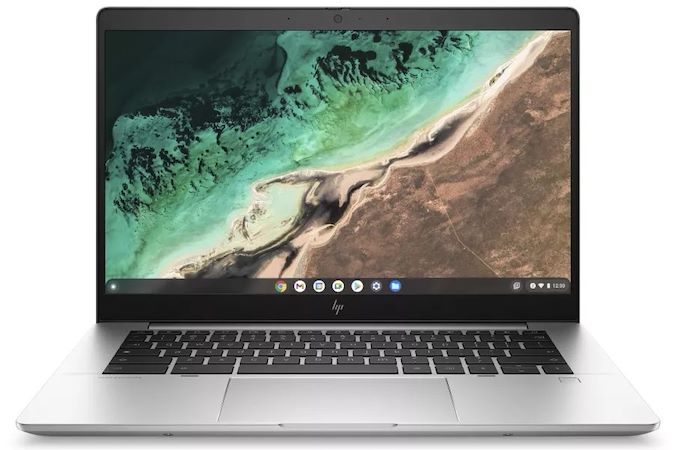
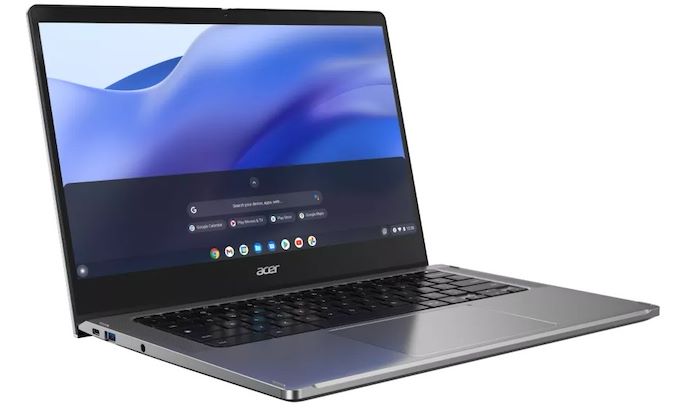








40 Comments
View All Comments
Samus - Friday, May 6, 2022 - link
Half of the transistors in Cezanne are fused off on 15W parts, only desktop parts get the full monty. The most powerful Cezanne ultramobile part, the 7 Pro 5850U, has 6.2 billion transistors enabled, or about 1/3rd that of an M1. I get the confusion because while products are manufactured with a certain number of transistors as a wow factor, that doesn't mean they are being used.https://chipguider.com/?proc=amd-ryzen-7-pro-5850u
All M1 parts are fully enabled. THAT'S THE PROBLEM. They depend on their power states to throttle.
Rembrandt will be no different in mobile form. TDP is determined by the laws of physics in a package, and active transistors = heat. Process for process, the same number of transistors across processors will determine the thermal envelope.
mode_13h - Saturday, May 7, 2022 - link
> All people talk about is the ALU and FPU performance, which is great> (still not on par with the Opteron A1100 25W ARM parts
That can't possibly be true. The A1100 was a 8x A57 CPU, made on 28 nm. Also, the 25 W version was only quad-core.
https://www.anandtech.com/show/9956/the-silver-lin...
Samus - Tuesday, May 10, 2022 - link
Yes, you are correct about all of that, apparently the quad core part was 32w, putting it in line with the M1, which is still beats in numerous tests. SpecInt_Rate for an A1100 quad core is 80, where it is 69.7 for the M1.Obviously the M1 is vastly superior in every other area, Opteron doesn't even have a GPU, but my point was to explain the ALU and FPU performance that everyone rants and raves about in M1 comes down to two things: ARM architecture and scale. Apple has the M1 run insanely high thermal envelope because they can get away with it at 5nm, but at a similar TDP to other ARM chips, it actually suffers in some areas because so many transistors have been dedicated to the GPU.
Samus - Tuesday, May 10, 2022 - link
*Octacore part was 32w. Need an edit button :(max - Sunday, May 8, 2022 - link
"It isn't appropriate for anything but $1000+ Apple devices."You can buy iPad AIR with M1 for $599, so I don't know what are you talking about. Apple sells MB Air M1 with 128GB SSD for $799 also. Google out "Apple US Education Institution – Hardware and Software Price List".
Qasar - Monday, May 9, 2022 - link
" Apple US Education Institution – Hardware and Software Price List"."of which do you need to be a student in order to use this ? if so, this is moot, and pointless to suggest, unless you also added " but to use this, you need to be a student.
max - Monday, May 9, 2022 - link
No, it isn’t. Sure it is offer for education, but the point is that Apple can make profit selling M1 hardware for less than $1000. So it is appropriate, and Apple could sell it for this price to anyone if they wanted to. Beside of this: don’t You know a student that can buy it for you? I’m sure 99% people on earth do have such option.mode_13h - Monday, May 9, 2022 - link
> Apple can make profit selling M1 hardware for less than $1000.But they get app store revenue. So, they could afford to sell the hardware at break-even or perhaps a small loss, with a reasonable assumption of making it back on software. Sort of like video game consoles.
Also, Apple's vertical integration helps them shave overheads that inflate pricing of competing products.
max - Monday, May 9, 2022 - link
"But they get app store revenue. So, they could afford to sell the hardware at break-even or perhaps a small loss, with a reasonable assumption of making it back on software. Sort of like video game consoles"Theoritically it is possible, but I don't think Apple is selling hadrware without profit to anyone. Even iPhone, which fits better in your non-profit story. Apple sells M1 iPad AIR for $599, so regular $800 price for MB Air is possible if they'll decide to lower the price. Maybe it'll happen on M2 premiere. Here's interesting article about savings from ARM M1 over Intel CPUs: https://sumitgup.medium.com/why-did-apple-build-th...
Qasar - Monday, May 9, 2022 - link
sorry max but you are kind of wrong. looks like you DO need to be a student in order to buy apple at those prices. https://www.apple.com/education/pricelists/ and i am sure there are plenty of restrictions as well.i dont know where you are getting your prices from but according to this page :
https://www.apple.com/us-edu/shop/buy-mac/macbook-...
the macbook air M1 starts @ 899
" don’t You know a student that can buy it for you? " as i said, there are probably restrictions and such that prevents this type of thing from happening. at least there is where i am.